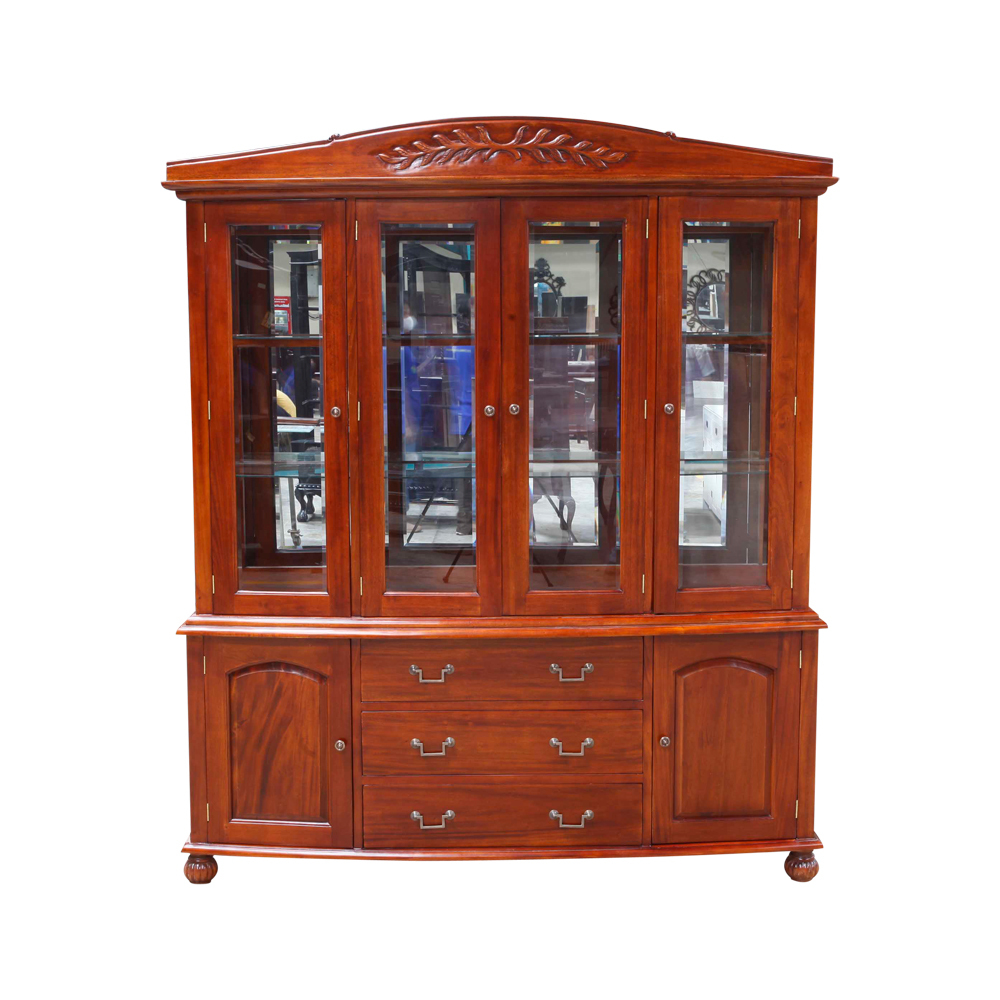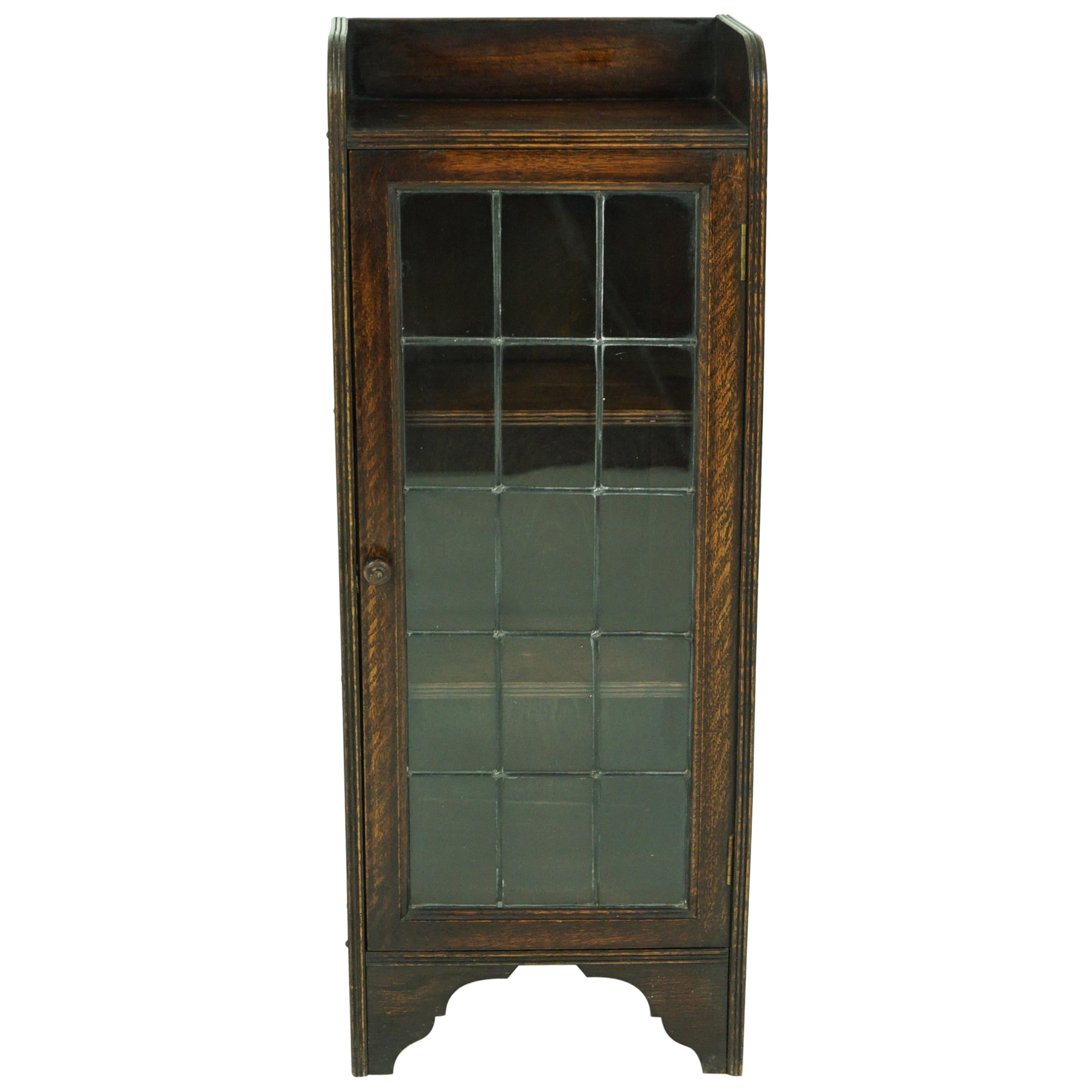History and Styles: Small Antique Cabinet With Glass Doors

Small antique cabinets with glass doors, often referred to as display cabinets or curio cabinets, have a rich history that spans centuries and reflects evolving tastes and trends in furniture design. These cabinets have served both functional and decorative purposes, showcasing prized possessions and adding elegance to homes.
Evolution of Styles
The evolution of small antique cabinets with glass doors is closely intertwined with the broader history of furniture design. Here’s a glimpse into some key periods and styles:
- Renaissance (14th-16th centuries): This period saw the emergence of cabinets with intricate carvings, often featuring classical motifs and mythological figures. These cabinets were typically made of walnut, oak, or cherry wood, and were often decorated with inlaid ivory, bone, or metal.
- Baroque (17th-18th centuries): The Baroque style emphasized grandeur and ornamentation. Cabinets from this era featured elaborate carvings, gilded surfaces, and often incorporated marble or bronze accents. These cabinets were typically made of mahogany or walnut wood, and often had multiple tiers and drawers.
- Rococo (18th century): This style emphasized lightness, grace, and elegance. Cabinets from this period were often made of lighter woods, such as cherry or maple, and featured delicate carvings and pastel colors. They often incorporated shell-like motifs and asymmetrical designs.
- Victorian (19th century): The Victorian era saw a wide range of cabinet styles, from Gothic Revival to Eastlake. Cabinets were often made of dark woods, such as rosewood or ebony, and featured intricate carvings, stained glass, and ornate hardware. They were frequently used to display collections of porcelain, china, or other decorative objects.
- Art Nouveau (late 19th-early 20th centuries): This style emphasized organic forms and flowing lines. Cabinets from this period were often made of exotic woods, such as mahogany or rosewood, and featured stylized floral motifs and geometric patterns. They were often decorated with metal accents and stained glass.
- Art Deco (1920s-1930s): This style emphasized geometric shapes, bold colors, and luxurious materials. Cabinets from this period were often made of exotic woods, such as macassar ebony or rosewood, and featured chrome accents and geometric patterns. They were often used to display modern art, sculptures, or other decorative objects.
Materials
The materials used to construct small antique cabinets with glass doors varied depending on the era and the desired aesthetic.
- Wood: Wood was the primary material used for cabinet construction throughout history. Popular woods included oak, walnut, cherry, mahogany, rosewood, and ebony. These woods were chosen for their durability, beauty, and workability.
- Metal: Metal accents were often used to enhance the beauty and functionality of cabinets. Metals like brass, bronze, iron, and silver were used for hinges, handles, feet, and decorative details. In some cases, metal was also used to construct the frame or the cabinet doors.
- Glass: Glass doors were a common feature of small antique cabinets, allowing for the display of prized possessions. The type of glass used varied depending on the era. Early cabinets often featured thick, hand-blown glass, while later cabinets incorporated thinner, machine-made glass.
Craftsmanship
The craftsmanship employed in creating small antique cabinets with glass doors was often highly skilled and involved meticulous attention to detail.
- Carving: Intricate carvings were often used to adorn cabinets, adding both beauty and visual interest. Carving techniques varied depending on the era and the style of the cabinet. Some common carving techniques included hand-carving, machine-carving, and relief carving.
- Inlay: Inlay was a technique used to decorate cabinets by inserting pieces of contrasting materials into the surface of the wood. Common inlay materials included ivory, bone, metal, and wood. Inlay patterns could be geometric, floral, or figurative.
- Veneering: Veneering involved applying thin sheets of wood to the surface of a cabinet to create a decorative effect. Veneers were often made from exotic woods, such as mahogany, rosewood, or ebony. They could be arranged in geometric patterns, floral motifs, or other designs.
- Painting and Gilding: Painting and gilding were often used to enhance the beauty and richness of cabinets. Paints were used to create a variety of finishes, from polished to distressed. Gilding involved applying thin sheets of gold leaf to the surface of the cabinet.
Function and Purpose

Small antique cabinets with glass doors, often referred to as display cabinets, have served a multitude of functions throughout history. These cabinets, crafted from various materials and adorned with intricate designs, were not only practical storage solutions but also reflected the tastes, values, and social standing of their owners.
Display and Preservation
The primary purpose of these cabinets was to display and preserve valuable possessions. Glass doors provided protection from dust, moisture, and potential damage, while also allowing for the objects within to be admired. This function was particularly relevant for families of wealth and status, who used these cabinets to showcase their prized heirlooms, collections of porcelain, silver, or other precious artifacts.
Storage and Organization
Beyond display, these cabinets served as practical storage solutions for various household items. They were used to store linens, china, and other delicate items, keeping them organized and readily accessible. The size and configuration of the cabinets, with shelves and drawers, were designed to accommodate specific needs, reflecting the lifestyles and preferences of their owners.
Symbolic Value
Antique cabinets with glass doors often held symbolic value, representing family history, cultural heritage, and social status. Their intricate designs and materials, such as hand-carved wood, inlaid ivory, or stained glass, reflected the craftsmanship and artistry of their era. These cabinets were often passed down through generations, serving as tangible reminders of family legacy and tradition.
Evolution of Function
The function of these cabinets has evolved over time, adapting to changing lifestyles and societal values. While they were once primarily used for display and storage of valuable possessions, they have also found new applications in modern homes. They can be used to showcase personal collections, decorative items, or even serve as a focal point in a room, adding a touch of elegance and sophistication.
Collecting and Appreciation

Collecting small antique cabinets with glass doors can be a rewarding and enriching experience, offering a glimpse into the past and a chance to own a piece of history. These cabinets, often crafted with meticulous detail and showcasing beautiful materials, can be admired for their craftsmanship, functionality, and historical significance.
Factors to Consider When Collecting
The decision to collect small antique cabinets with glass doors should be guided by a thoughtful approach, taking into account several key factors.
- Personal Interest: A strong personal interest in the style, period, or materials of the cabinets is crucial. This passion will drive your search, inform your choices, and enhance your enjoyment of the collection.
- Budget: Antique cabinets can range in price significantly, from modest to highly valuable. Establish a realistic budget and stick to it to avoid overspending.
- Space: Consider the available space in your home to accommodate the cabinets. Smaller cabinets are often more manageable for limited spaces, but ensure they fit your existing décor and overall aesthetic.
- Condition: The condition of the cabinet is a major factor influencing its value. Look for pieces that are well-preserved and have minimal damage. Restoration and conservation can enhance the condition, but should be done by experienced professionals.
- Provenance: If possible, try to ascertain the origin and history of the cabinet. Knowing its past adds to its value and historical significance. Authenticating provenance can involve researching markings, labels, and other identifying features.
Authenticating and Valuing Antique Cabinets, Small antique cabinet with glass doors
Authenticating and valuing antique cabinets with glass doors can be a complex process, requiring a combination of knowledge, research, and expert appraisal.
- Research: Start by researching the style, period, and maker of the cabinet. Books, online databases, and museums can provide valuable information. Look for similar pieces to compare and learn from.
- Expert Appraisal: An experienced antique appraiser can provide a professional assessment of the cabinet’s authenticity and value. They will examine its construction, materials, and any identifying marks or labels.
- Condition Assessment: The condition of the cabinet is a crucial factor in its value. Minor wear and tear are expected, but major damage or repairs can significantly reduce its worth. Look for signs of restoration or alteration, as these can affect the cabinet’s value.
- Market Trends: Keep an eye on current market trends for antique cabinets. Prices can fluctuate based on demand, rarity, and overall market conditions.
Restoration and Conservation
Restoration and conservation play a vital role in preserving the historical and aesthetic value of antique cabinets. These processes require careful consideration and should be undertaken by skilled professionals.
- Restoration: Restoration involves repairing or replacing damaged parts to restore the cabinet to its original condition. It is a delicate process that requires expertise and a deep understanding of the cabinet’s construction and materials.
- Conservation: Conservation focuses on preserving the cabinet’s original materials and structure, minimizing intervention and maximizing its longevity. It involves cleaning, stabilizing, and protecting the cabinet from further deterioration.
- Ethical Considerations: Restoration and conservation should be undertaken ethically, preserving the cabinet’s historical integrity and avoiding unnecessary alterations. Consult with experienced professionals to ensure that the process is appropriate and respects the cabinet’s value.
Small antique cabinet with glass doors – Small antique cabinets with glass doors, often crafted from intricate wood and adorned with delicate brass accents, are a testament to bygone craftsmanship. These cabinets, with their ability to display cherished objects, offer a glimpse into the past, much like a visit to a luxurious suite in a grand hotel.
For instance, the Caesar’s 2 bedroom suite boasts a similar air of sophistication and historical charm, offering a curated experience that blends comfort and elegance. The intricate details and the carefully selected furnishings within these suites mirror the meticulous artistry often found in antique cabinets with glass doors.
Small antique cabinets with glass doors often feature intricate carvings and ornate hardware, showcasing the craftsmanship of a bygone era. While these pieces possess a timeless elegance, contemporary designs offer a different aesthetic, such as white cabinets with frosted glass , which provide a clean and minimalist look.
Regardless of style, cabinets with glass doors offer a practical solution for displaying cherished objects while keeping them protected from dust and damage.
